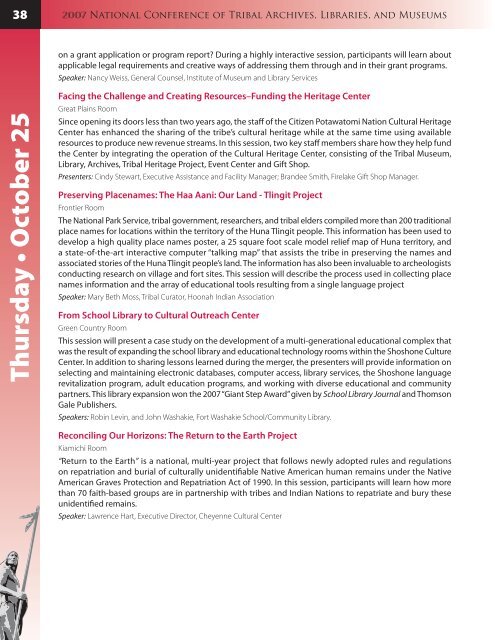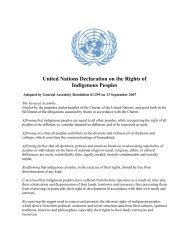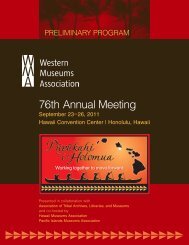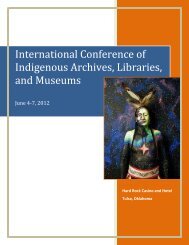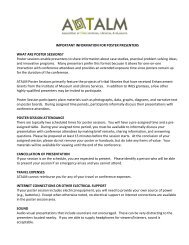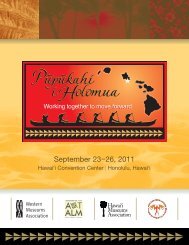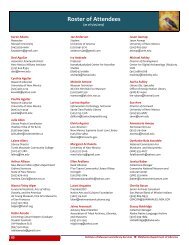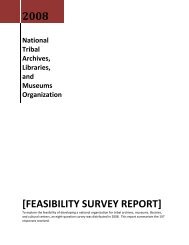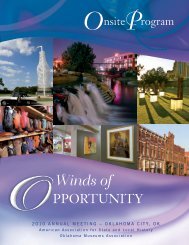2007 - ATALM | Association of Tribal Archives, Libraries, & Museums
2007 - ATALM | Association of Tribal Archives, Libraries, & Museums
2007 - ATALM | Association of Tribal Archives, Libraries, & Museums
Create successful ePaper yourself
Turn your PDF publications into a flip-book with our unique Google optimized e-Paper software.
38 <strong>2007</strong> National Conference <strong>of</strong> <strong>Tribal</strong> <strong>Archives</strong>, <strong>Libraries</strong>, and <strong>Museums</strong><br />
on a grant application or program report During a highly interactive session, participants will learn about<br />
applicable legal requirements and creative ways <strong>of</strong> addressing them through and in their grant programs.<br />
Speaker: Nancy Weiss, General Counsel, Institute <strong>of</strong> Museum and Library Services<br />
<br />
Facing the Challenge and Creating Resources–Funding the Heritage Center<br />
Great Plains Room<br />
Since opening its doors less than two years ago, the staff <strong>of</strong> the Citizen Potawatomi Nation Cultural Heritage<br />
Center has enhanced the sharing <strong>of</strong> the tribe’s cultural heritage while at the same time using available<br />
resources to produce new revenue streams. In this session, two key staff members share how they help fund<br />
the Center by integrating the operation <strong>of</strong> the Cultural Heritage Center, consisting <strong>of</strong> the <strong>Tribal</strong> Museum,<br />
Library, <strong>Archives</strong>, <strong>Tribal</strong> Heritage Project, Event Center and Gift Shop.<br />
Presenters: Cindy Stewart, Executive Assistance and Facility Manager; Brandee Smith, Firelake Gift Shop Manager.<br />
Preserving Placenames: The Haa Aani: Our Land - Tlingit Project<br />
Frontier Room<br />
The National Park Service, tribal government, researchers, and tribal elders compiled more than 200 traditional<br />
place names for locations within the territory <strong>of</strong> the Huna Tlingit people. This information has been used to<br />
develop a high quality place names poster, a 25 square foot scale model relief map <strong>of</strong> Huna territory, and<br />
a state-<strong>of</strong>-the-art interactive computer “talking map” that assists the tribe in preserving the names and<br />
associated stories <strong>of</strong> the Huna Tlingit people’s land. The information has also been invaluable to archeologists<br />
conducting research on village and fort sites. This session will describe the process used in collecting place<br />
names information and the array <strong>of</strong> educational tools resulting from a single language project<br />
Speaker: Mary Beth Moss, <strong>Tribal</strong> Curator, Hoonah Indian <strong>Association</strong><br />
From School Library to Cultural Outreach Center<br />
Green Country Room<br />
This session will present a case study on the development <strong>of</strong> a multi-generational educational complex that<br />
was the result <strong>of</strong> expanding the school library and educational technology rooms within the Shoshone Culture<br />
Center. In addition to sharing lessons learned during the merger, the presenters will provide information on<br />
selecting and maintaining electronic databases, computer access, library services, the Shoshone language<br />
revitalization program, adult education programs, and working with diverse educational and community<br />
partners. This library expansion won the <strong>2007</strong> “Giant Step Award” given by School Library Journal and Thomson<br />
Gale Publishers.<br />
Speakers: Robin Levin, and John Washakie, Fort Washakie School/Community Library.<br />
Reconciling Our Horizons: The Return to the Earth Project<br />
Kiamichi Room<br />
“Return to the Earth” is a national, multi-year project that follows newly adopted rules and regulations<br />
on repatriation and burial <strong>of</strong> culturally unidentifiable Native American human remains under the Native<br />
American Graves Protection and Repatriation Act <strong>of</strong> 1990. In this session, participants will learn how more<br />
than 70 faith-based groups are in partnership with tribes and Indian Nations to repatriate and bury these<br />
unidentified remains.<br />
Speaker: Lawrence Hart, Executive Director, Cheyenne Cultural Center


